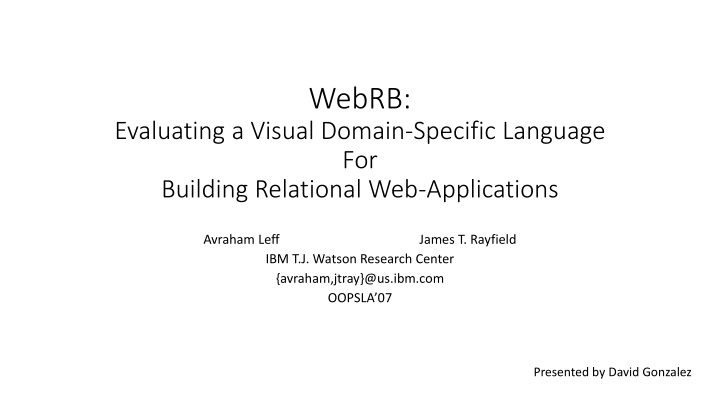
Evaluating WebRB: A Visual Language for Relational Web Applications
Discover insights on WebRB, a visual domain-specific language for building relational web applications, detailing its key features, problems addressed, implementation approach, and evaluation results. Explore how it aims to bridge the gap between imperative languages and relational design in web development.
Download Presentation

Please find below an Image/Link to download the presentation.
The content on the website is provided AS IS for your information and personal use only. It may not be sold, licensed, or shared on other websites without obtaining consent from the author. If you encounter any issues during the download, it is possible that the publisher has removed the file from their server.
You are allowed to download the files provided on this website for personal or commercial use, subject to the condition that they are used lawfully. All files are the property of their respective owners.
The content on the website is provided AS IS for your information and personal use only. It may not be sold, licensed, or shared on other websites without obtaining consent from the author.
E N D
Presentation Transcript
WebRB: Evaluating a Visual Domain-Specific Language For Building Relational Web-Applications Avraham Leff James T. Rayfield IBM T.J. Watson Research Center {avraham,jtray}@us.ibm.com OOPSLA 07 Presented by David Gonzalez
Key Insights: WebRB is a visual domain-specific language for writing applications , which provides: An API (and dataflow) for CRUD operations: server-side relational model to the client-side view, and client-side event-handling for reflecting changes back to the other-side. Relational algebra for expressing business logic. A visual programming language for building client-side views and their logic.
Problem(1/2) From Imperative-Embedding: Web applications are written with imperative languages (Java, PHP). To Relational: since an all visual technique for designing web-pages would seem to be more natural. Context: Front-end development was not what it is now. Ajax was starting. Circa 2006 had its first draft proposed by the W3C.
Problem(2/2) Specifically, relational web-applications : 1. Read relational databases and present the data in a GUI 2. Update relational databases based on a user s interaction with the GUI 3. Perform transformations of the relational data which require only simple or moderately complex business logic
Approach(1/3) Implementation: Server-Side: PHP and DB2 Client-Side: JavaScript Specification Format: XML
Approach(2/3) Blocks: I/O Elements Pins: I/O indicators Wires: Dataflow
Approach(3/3) Page Input!
Results Evaluation Feature Analysis*: The language uses a relatively small number of abstractions. Provides excellent closeness-of-mapping for the application UI and less clear for database tables. Attempts to be very consistent where most UI elements let any input may be connected to any output. Visual components take more screen space than text-based equivalents. Provides good visibility for blocks and dataflow at the page level. * T. R. G. Green and M. Petre. Usability analysis of visual programming environments: a cognitive dimensions framework. J. Visual Languages and Computing, 7(2):131 174, 1996.
Questions? Thanks! What about the page editor? What about the property editor? What about the dataflow? What about using the best of the two worlds?
